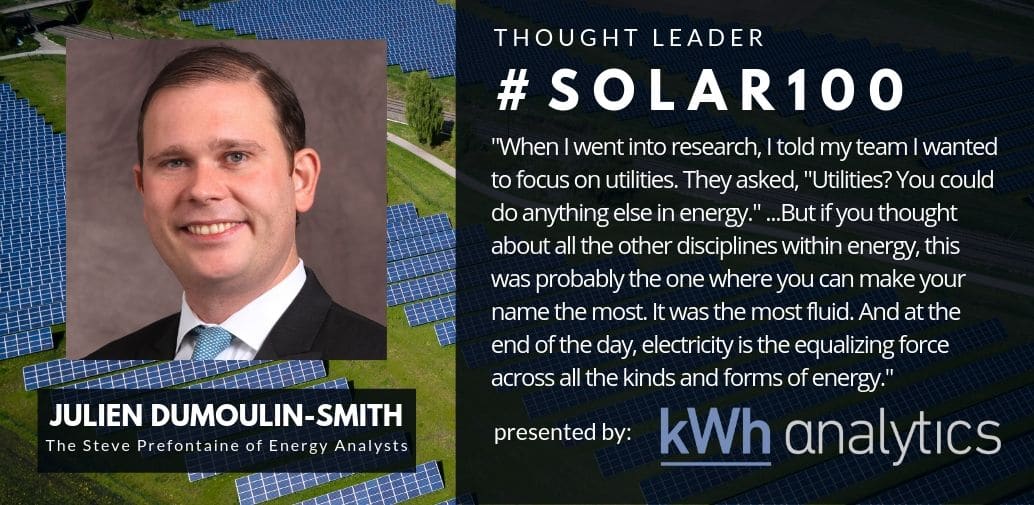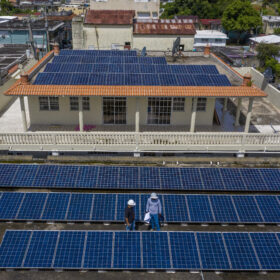Between his deliberate training, his bordering infamous toughness about his craft, his recognition as the “Top Ranked Equities Analyst covering Power, Utilities, and Renewables,” and the kind of swagger that comes from knowing you’ve made yourself into one of the best, Dumoulin-Smith is perhaps as close as they come to a Prefontaine in the world of energy analysts.
In this interview, Dumoulin-Smith considers the future of the ITC, utility rate-basing of solar, and solar refinancing.
Born for this job
Richard Matsui: You have your B.S. from Columbia in Applied Math, and Triple Minored in Economics, Political Science, and Environmental Engineering. That seems like a perfect setup for a career as an analyst in the energy sector. Did you always know you wanted this path?
Julien Dumoulin-Smith: Absolutely. I knew I wanted to do energy—when I realized that there were also political and economic angles to energy, I made my decision. That was it. When I went into research, I told my team I want to focus on utilities. They asked, “Utilities? You could do anything else in energy.” They were surprised, but I made this decision in 2006, in the shadow of Enron’s 2001 scandal. I was doing an internship full time, and the context was appealing given how ill-defined the opportunities still were in utilities and electricity. Utilities are the confluence of all of the different forms of energy, and restructuring was particularly intriguing at the time because it wasn’t a known commodity—it wasn’t straightforward. If you thought about all the other disciplines within energy, this was probably the one where you can make your name the most. It was the most fluid. And at the end of the day, electricity is the equalizing force across all the kinds and forms of energy.
Richard Matsui: So your decision to go into energy and utilities driven by the underappreciated nature of the field at the time?
Julien Dumoulin-Smith: Coming from New York, energy research was the way to have the biggest impact; I wanted to make a dent in the industry as quickly as possible, and equity research was a really good platform for that.
Richard Matsui: A big part of the job is knowing who to listen to and who to ignore. Who in the energy industry do you pay close attention to?
Julien Dumoulin-Smith: I listen to the executive team at Hannon Armstrong pretty closely, because they have a very good handle on what’s going on in the renewable space. They don’t necessarily write articles because they’re a small capital company, but they have a very good pulse on the market. I’m partial because of my set of experiences, but I think they have a very good sense of the breadth of what’s going on in the space because they are a specialty renewable energy finance vehicle.
Michael O’Sullivan over at NextEra is a rising star. He doesn’t talk publicly very frequently, but when O’Sullivan speaks, I listen very closely.
The giants are stirring: utilities
Richard Matsui: Who are the natural owners of solar assets?
Julien Dumoulin-Smith: There’s no clear-cut answer. It depends on the risk profile and in the growth trajectory of different subsectors and niches. That being said, we are seeing clear-cut trends towards private capital. Their ability to pay up higher valuations drives acquisition volumes in their favor. This isn’t categorically true, but the dearth of expansions of YieldCos speaks to that perception. Where is the opportunity? Maybe it isn’t necessarily in YieldCo expansion, although I don’t necessarily want to suggest that YieldCos can’t continue to expand. I see no reason they couldn’t. The fact that we haven’t seen more expansion of the YieldCo asset class is a result of the challenges of competing with outright private capital. The consolidation of YieldCo and YieldCo-like vehicles into outright private capital structures, or quasi private capital structures, is also an extraordinarily relevant trend.
At the same time, I would also say that returns are made outside of down-the-fairway utility-scale solar. There’s no definitive home for behind-the-meter assets, which the growth trajectory of behind-the-meter assets validates. Valuation metrics drive decisions. As an investor, are you looking at tax credits, levelized cashflow, or post-flip cashflow? The upfront cashflow that renewable assets generate is particularly appealing to those who develop assets through strategics, like utilities.
For the time being, we’re still going to see new development efforts undertaken as strategic. As the tax credit incentives roll off, we’re going to see less and less of that, which is a pretty interesting trend at the end of the day. What is more intriguing today is what impact the declining tax credit availability will have on the willingness for strategics to participate. The return on equity versus the internal rate of return is much higher with the tax structures and tax credits available today, specifically the Investment Tax Credit (ITC).
One final caveat: utility-owned rate-based is not pervasive enough yet. It will be more pervasive in the future.
Richard Matsui: I’ve read your prior research notes on the few utilities that are starting to successfully push into rate-basing solar. Is that really going to become a significant trend? I’m from Hawaii and work in California, where both PUCs have categorically stated that the future of the utility business model will be “wires only” companies. That’s the regulatory angle.
Julien Dumoulin-Smith: Why wouldn’t utilities naturally own the assets? They have historically. I would argue that unless you’re going to change the business model, there’s no reason for that to shift. There is tension embedded in rate-based versus contracted opportunities, there’s cost of capital and attention discrepancies that exist there. That’s the real question: Who is more competitive? Can utilities be truly cost competitive?
The Michigan Integrated Resource plan that was recently adopted shows that if you’re going to build a utility rate base, a lot of the rate base has to get vetted and compete through competitive RFPs with other alternatives. I think rate-based eligibility is going to become far more widespread than it was when you were building truly large scale capital with a competitive backdrop. Coal plants and nuclear plants were never done on RFPs before. Solar is much more ad hoc and allow for that kind of a construct to exist.
Richard Matsui: My understanding of the utility regulatory compact, for the states with regulated markets, is that the utility is allowed this monopolistic power, but only when the private sector is not able to provide that service. Is that the right framework to think about this?
Julien Dumoulin-Smith: I don’t think that utilities are going to be wires-only in the future. Globally, restructured markets are more pervasive. I don’t expect states to return to restructured markets, and so as long as that’s the case, defining deregulation becomes ever more ambiguous. Is it deregulation of customer choice or is it deregulation in competitive dynamics around the energy generation supply choices that are being made on behalf of customers?
Frankly, I think customer choice is on the reversal here. While California is quasi-deregulating, New York and Massachusetts are protecting the customer ratepayers from all sorts of practices that have become controversial. It goes both ways here. Competitive generation procurement has clearly been a friend of the state. The state of the US is going to continue to be different than procurement elsewhere in the world where there’s a fully restructured market.
Richard Matsui: Could you expand on why the ITC disadvantages utilities from being as competitive in this space?
Julien Dumoulin-Smith: There are dual dynamics. One is that the ITC itself produces high up-front ROIs for those investing outside of rate-base. For those investing in rate base, the problem is the amortization of the tax credit over the life of the asset, and whether that creates a competitive cost to capital versus independent developers. At end of the day, a lot of regulators have come up and gotten comparable structures that will allow for utility rate-based solar. We’ve seen examples of this already, and whether you’re looking at Indiana or California as the leaders, others are going to follow. Rate-based solar is happening.
The giants are stirring: YieldCos
Richard Matsui: What happens to YieldCos, given their cost of capital? I haven’t heard discussion of a possible collapse since the post-SunEdison era. Though are these companies valued strictly as net present value of their current portfolio, or is there a valuation premium embedded in a growth story?
Julien Dumoulin-Smith: That’s a great question. I don’t think there’s an argument that YieldCos collapse. At the end of the day, YieldCos have a very tangible value. They may be interest rate sensitive, but I don’t think there’s a collapse coming by any means. The underlying tension creeps in when you ask, “To what extent can you sustainably expect for assets to trade at a premium?” There’s been an underlying tension in the sector between paying for yields versus looking at assets on an IRR basis and trying to reconcile the two. The idea that one front end loads the return of capital more broadly in one structure versus another, speaks to getting a dividend that has not just a return on capital, but the return of capital baked into it as well.
To answer your question more directly, I don’t think there’s a fundamental issue with YieldCos. Are they going to sit there and not grow? I don’t think so. They traded above NPV (Net Present Value), and if they can be competitive against private capital, they will continue to grow, with or without sponsors. They just need to prove that that there’s a cost to capital spread on what they’re announcing versus their own cost of capital. That’s what has been difficult to decipher on a consistent basis.
The trend to watch: REFI
Richard Matsui: In your August research note, you identified refinancings as the “trend to watch.” We are seeing similar trends in our latest Lendscape update, and discussed it on Norton Rose Fulbright’s recently released Currents Episode 70 on refinancing. Can you provide some additional context on refi as a growing trend?
Julien Dumoulin-Smith: Certainly. Among the most important dynamics arising out of the recent quarter are prospects for refinancing to take advantage of the lower rate environment. Many companies are only beginning this planning now. We would not be surprised to see an uptick post-August slowdown and into the EEI financial reset in November. NextEra Energy was the only utility to emphasize this element with 2Q (and speaks to its higher quality among peers) guiding implicitly lower within its 2019 EPS range as it intends to payout against make-whole arrangements; we could see others follow suit given their leverage. Meanwhile, we see this as only enabling further reductions in renewable costs/financing terms for the resi & utility-sector alike in 2H.
Richard Matsui: Yes, refinancing in this environment makes a lot of sense. Looking at the Lendscape, these 50 sponsors account for $35b of solar projects. If those sponsors were to refinance their assets that are 2+ years old, they would unlock $1b of cash while locking in these record-low spreads and rates. When we do the math for the broader industry, there’s an opportunity for our industry to put $3b into the treasury. It’s hard to understate how big of an opportunity this is for the industry, especially given the macroeconomic uncertainty ahead.
Wall Street’s view on the ITC extension
Richard Matsui: What does the stock market currently believe will happen to the ITC?
Julien Dumoulin-Smith: Our expectations have been focused on the storage side of the ITC equation. I’m not holding my breath for a solar extension. I don’t want to predict politics per se, but I would emphasize that the real debate is how to structure the most impactful storage tax credit structure possible. Rather than necessarily banking on the extension of the tax credit, what does that level need to be? Particularly given that the tax credit does not expire, but drops from 30%.
Richard Matsui: Fair point. It seems that the market you’re describing has a step down on the source side at least, and that’s how the status quo continues. Last quarter, I read an article in SparkSpread about eight different solar developers who were considering safe harboring of equipment. Effectively, they’re betting on the status quo, that there is no extension of the 30% ITC. Do you see any other implications on the horizon?
Julien Dumoulin-Smith: To not have an ITC safe harboring strategy is to ignore the opportunities that exist. Companies need to have a safe harboring strategy in order to continue into the future. Whether or not there’s an extension of the ITC will shape the magnitude and the tailoring of the specifics of an ITC department strategy. But I think that the ITC safe harbor already provides substantial flexibility. The caveat there is the pricing on panels if you haven’t already made orders, and the availability in 4Q19 or 1Q20 for delivery in order to qualify for safe harbor is so limited and the pricing is so much higher that establishing a policy today becomes a little trickier.
Energy Storage: is it a land grab?
Richard Matsui: Returning to energy storage. Has the industry started to oversell storage at this point? Like everyone else in the industry, I’ve been amazed by the record-low prices on solar plus storage, and my assumption is that the margins must be thin. Knowing my colleagues in the solar industry, I wonder if this is a land grab, rather than a profit-driven kind of deal announcements. Historically speaking, land grab mentalities have ended poorly in the renewables space, so I’d love to hear your thoughts on how this plays out.
Julien Dumoulin-Smith: We’re referring to procurements offered by these utilities, so realistically the price of storage is very cheap and that’s why the developers are willing to sell it to us at that price. But the question really is: Is cost of capital sustainably low, especially in the context of storage + solar? I’ve seen that storage actually appears to have a uniquely attractive return profile, as we’ve seen in California, in Moss Landing. I don’t think that this is a very low cost of capital business, necessarily. There aren’t a lot of data points to point to on utility scale storage procurement anyway. That’s part one. Part two is that solar projects have modest amounts of incremental storage. We aren’t necessarily pairing storage with every megawatt of solar—it’s a percentage of it, and it tends to be shorter duration. That is where you’ve got to be really careful with these quoting PPA prices as well. There’s no standardization yet of what exactly solar + storage really is, because storage is an undefined product today.
Editor’s note: This is an interview in the #Solar100 Thought Leaders series. More interviews can be found on the #Solar100 page.
This content is protected by copyright and may not be reused. If you want to cooperate with us and would like to reuse some of our content, please contact: editors@pv-magazine.com.







By submitting this form you agree to pv magazine using your data for the purposes of publishing your comment.
Your personal data will only be disclosed or otherwise transmitted to third parties for the purposes of spam filtering or if this is necessary for technical maintenance of the website. Any other transfer to third parties will not take place unless this is justified on the basis of applicable data protection regulations or if pv magazine is legally obliged to do so.
You may revoke this consent at any time with effect for the future, in which case your personal data will be deleted immediately. Otherwise, your data will be deleted if pv magazine has processed your request or the purpose of data storage is fulfilled.
Further information on data privacy can be found in our Data Protection Policy.